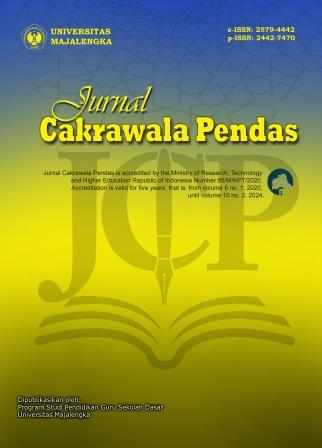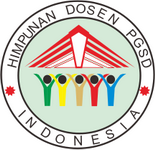DIGITAL SCIENCE TEACHING MATERIALS INTEGRATED WITH SCAFFOLDING PROBLEM-BASED LEARNING FOR PROBLEM-SOLVING AND SCIENTIFIC REASONING SKILLS OF PROSPECTIVE MADRASAH IBTIDAIYAH TEACHERS ON KINEMATICS MATERIAL
DOI:
https://doi.org/10.31949/jcp.v9i1.3719Abstract
The ability to solve problems and reason scientifically is needed by prospective elementary schools or Madrasah Ibtidaiyah teachers to meet the demands of the 21st century. This study aimed to determine the effect of digital science teaching materials based on scaffolding problem-based learning on students' scientific thinking skills and problem-solving. This research is quasi-experimental quantitative research with a pre-test-post-control group design. The sample of this study was 24 PGMI students at UIN Maulana Malik Ibrahim Malang who chose the concentration of Natural Sciences. The research instrument used scientific reasoning tests and problem-solving, which consisted of five descriptive questions. Data analysis was performed using paired sample t-test. Data analysis showed that students who used scaffolding problem-based learning digital science teaching materials had higher scientific thinking and problem-solving skills than those who did not use these materials. Therefore, it can be concluded that digital science material influences students' scientific thinking skills and problem-solving.
Kemampuan memecahkan masalah dan bernalar secara ilmiah sangat dibutuhkan calon guru sekolah dasar atau Madrasah Ibtidaiyah untuk memenuhi tuntutan abad 21. Tujuan pelaksanaan riset berikut guna memberi pendeskripsian pengaruhnya bahan ajar sains digital berbasiskan scaffolding problem-based learning terhadap kemampuan berpikir ilmiah dan pemecahan permasalahan mahasiswa. Riset berikut ialah riset kuantitatif dengan desain kuasi eksperimen pre-post-control group design. Sampel penelitian ini adalah 24 mahasiswa PGMI UIN Maulana Malik Ibrahim Malang yang memilih konsentrasi Ilmu Pengetahuan Alam. Instrumen penelitian ini menggunakan tes penalaran ilmiah dan pemecahan masalah yang terdiri dari lima pertanyaan deskriptif. Analisis data dilakukan dengan menggunakan uji-t sampel berpasangan. Analisis data menandakan yakni murid yang mempergunakan bahan ajar digital sains berbasis scaffolding PBL memiliki tingkat berpikir ilmiah dan keterampilan pemecahan masalah yang lebih tinggi daripada siswa yang tidak menggunakan bahan tersebut. maka begitu, berkeismpulan yakni bahan ajar sains digital berbasiskan scaffolding PBL membawa pengaruh kepada keterampilan berpikir ilmiah dan pemecahan masalah siswa.
Keywords:
Scaffolding, Problem Based Learning, Scientific Explanation, Problem Solving SkillsDownloads
References
Alshamali, M. A., & Daher, W. M. (2016). Scientific reasoning and its relationship with problem-solving: The case of upper primary science teachers. International Journal of Science and Mathematics Education, 14(6), 1003–1019.
Amelia, R. (2021a). Development of web e-scaffolding based on scientific explanation as teaching materials for primary school pre-service teachers. Al Ibtida: Jurnal Pendidikan Guru MI, 8(2), 144–160.
Amelia, R. (2021b). The influence of e-scaffolding in blended learning on prospective teacher's scientific explanation. Journal of Physics: Conference Series, 1796(1), 012039.
Amelia, R., Handayanto, S. K., & Muhardjito, M. (2016). The Influence of V Diagram Procedural Scaffolding in Group Investigation Towards Students with High and Low Prior Knowledge. Jurnal Pendidikan IPA Indonesia, 5(1), 108–115.
Amelia, R., Rofiki, I., Tortop, H. S., & Abah, J. A. (2020). Pre-service teachers' scientific explanation with e-scaffolding in blended learning. Jurnal Ilmiah Pendidikan Fisika Al Biruni, 9(1), 33–40.
Cheng, P.-J., Liao, Y.-H., & Yu, P.-T. (2021). Micro: Bit Robotics Course: Infusing Logical Reasoning and Problem-Solving Ability in Fifth Grade Students Through an Online Group Study System. International Review of Research in Open and Distributed Learning, 22(1), 21–40.
Csanadi, A., Kollar, I., & Fischer, F. (2016). Scientific reasoning and problem solving in a practical domain: Are two heads better than one? Singapore: International Society of the Learning Sciences.
Ersoy, E. (2014). The effects of problem-based learning method in higher education on creative thinking. Procedia-Social and Behavioral Sciences, 116, 3494–3498.
Gita, I. N., & Apsari, R. A. (2018a). Scaffolding in problem-based learning to increase students' achievements in linear algebra. Journal of Physics: Conference Series, 1040(1), 012024.
Gita, I. N., & Apsari, R. A. (2018b). Scaffolding in problem-based learning to increase students' achievements in linear algebra. Journal of Physics: Conference Series, 1040(1), 012024.
Hung, C.-M., Huang, I., & Hwang, G.-J. (2014a). Effects of digital game-based learning on students' self-efficacy, motivation, anxiety, and achievements in learning mathematics. Journal of Computers in Education, 1(2), 151–166.
Hung, C.-M., Huang, I., & Hwang, G.-J. (2014b). Effects of digital game-based learning on students' self-efficacy, motivation, anxiety, and achievements in learning mathematics. Journal of Computers in Education, 1(2), 151–166.
Kadir, Z. A., Abdullah, N. H., Anthony, E., Salleh, B. M., & Kamarulzaman, R. (2016). Does Problem-Based Learning Improve Problem Solving Skills?—A Study among Business Undergraduates at Malaysian Premier Technical University. International Education Studies, 9(5), 166–172.
Kim, N. J., Belland, B. R., & Walker, A. E. (2018). Effectiveness of computer-based scaffolding in the context of problem-based learning for STEM education: Bayesian meta-analysis. Educational Psychology Review, 30(2), 397–429.
Koes-H, S., Suwasono, P., & Pramono, N. A. (2019). Efforts to improve problem solving abilities in physics through e-scaffolding in hybrid learning. AIP Conference Proceedings, 2081(1), 030006.
Kusumah, R. G. T. (2019). Peningkatan Kemampuan Berfikir Kritis Mahasiswa Tadris IPA Melalui Pendekatan Saintifik Pada Mata kuliah IPA Terpadu. IJIS Edu: Indonesian Journal of Integrated Science Education, 1(1), 71–84.
McNeill, K. L. (2011). Elementary students' views of explanation, argumentation, and evidence, and their abilities to construct arguments over the school year. Journal of Research in Science Teaching, 48(7), 793–823.
Milbourne, J., & Wiebe, E. (2018). The role of content knowledge in ill-structured problem solving for high school physics students. Research in Science Education, 48(1), 165–179.
Nugraheni, D. (2017). Analisis kesulitan belajar mahasiswa pada mata kuliah mekanika. Edu Sains: Jurnal Pendidikan Sains dan Matematika, 5(1), 23–32.
Nurhayati, N. (2016). Instrumen Pembelajaran Untuk Pola Penalaran Dan Kemampuan Penyelesaian Masalah Sintesis. JURNAL PEMBELAJARAN FISIKA, 4(5), 242–249.
Oktavianti, E., Handayanto, S. K., Wartono, W., & Saniso, E. (2018). Studentsâ€TM' Scientific Explanation in Blended Physics Learning with E-Scaffolding. Jurnal Pendidikan IPA Indonesia, 7(2), 181–186.
Rubric, C. E. V. (2010). Association of American Colleges and Universities. Retrieved January 19.
Saleh, A., Silver, C. H., Chen, Y., Shanahan, K., Rowe, J., & Lester, J. (2018). Scaffolding peer facilitation in computer-supported problem-based learning environments. International Society of the Learning Sciences, Inc.[ISLS].
Sani, R. A., & Malau, T. (2017). The effect of problem based learning (PBL) model and self regulated learning (SRL) toward physics problem solving ability (PSA) of students at senior high school. American Journal of Educational Research, 5(3), 279–283.
Saputri, A. A., & Wilujeng, I. (2017). Developing Physics E-Scaffolding Teaching Media to Increase the Eleventh-Grade Students' Problem Solving Ability and Scientific Attitude. International Journal of Environmental and Science Education, 12(4), 729–745.
Sarah, L. L. (2022). The Implementation of Web Based E-Scaffolding Enhance Learning (ESEL) on Centre of Mass Concept Understanding. Jurnal Inovasi Pendidikan IPA, 8(1).
van Riesen, S. A., Gijlers, H., Anjewierden, A., & de Jong, T. (2018). The influence of prior knowledge on experiment design guidance in a science inquiry context. International journal of science education, 40(11), 1327–1344.
Wu, J., Guo, R., Wang, Z., & Zeng, R. (2021). Integrating spherical video-based virtual reality into elementary school students' scientific inquiry instruction: Effects on their problem-solving performance. Interactive Learning Environments, 29(3), 496–509.
Zwart, D. P., Van Luit, J. E., Noroozi, O., & Goei, S. L. (2017). The effects of digital learning material on students' mathematics learning in vocational education. Cogent Education, 4(1), 1313581.
Published
How to Cite
Issue
Section
License
Copyright (c) 2023 Rizki Amelia, Ahmad Abtokhi

This work is licensed under a Creative Commons Attribution-ShareAlike 4.0 International License.
Authors who publish with this journal agree to the following terms:
- Authors retain copyright and grant the journal right of first publication with the work simultaneously licensed under a Creative Commons Attribution License that allows others to share the work with an acknowledgment of the work's authorship and initial publication in this journal.
- Authors are able to enter into separate, additional contractual arrangements for the non-exclusive distribution of the journal's published version of the work (e.g., post it to an institutional repository or publish it in a book), with an acknowledgment of its initial publication in this journal.
- Authors are permitted and encouraged to post their work online (e.g., in institutional repositories or on their website) prior to and during the submission process, as it can lead to productive exchanges, as well as earlier and greater citation of published work (See The Effect of Open Access).



